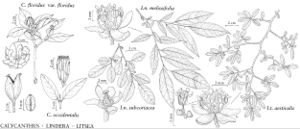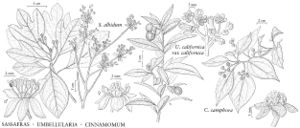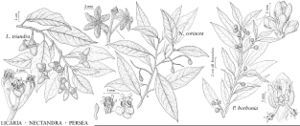Lauraceae
Shrubs to tall trees, evergreen or rarely deciduous (Cassytha a parasitic vine with leaves reduced to scales), usually aromatic. Leaves alternate, rarely whorled or opposite, simple, without stipules, petiolate. Leaf blade: unlobed (unlobed or lobed in Sassafras), margins entire, occasionally with domatia (crevices or hollows serving as lodging for mites) in axils of main lateral veins (in Cinnamomum). Inflorescences in axils of leaves or deciduous bracts, panicles (rarely heads), racemes, compound cymes, or pseudoumbels (spikes in Cassytha), sometimes enclosed by decussate bracts. Flowers bisexual or unisexual, bisexual only, or staminate and pistillate on different plants, or staminate and bisexual on some plants, pistillate and bisexual on others; flowers usually yellow to greenish or white, rarely reddish; hypanthium well developed, resembling calyx tube, tepals and stamens perigynous; tepals 6(-9), in 2(-3) whorls of 3, sepaloid, equal or rarely unequal, if unequal then usually outer 3 smaller than inner 3 (occasionally absent in Litsea); stamens (3-)9(-12), in whorls of 3, but 1 or more whorls frequently staminodial or absent; stamens of 3d whorl with 2 glands near base; anthers 2- or 4-locular, locules opening by valves; pistil 1, 1-carpellate; ovary 1-locular; placentation basal; ovule 1; stigma subsessile, discoid or capitate. Fruits drupes, drupe borne on pedicel with or without persistent tepals at base, or seated in ± deeply cup-shaped receptacle (cupule), or enclosed in accrescent floral tube. Seed 1; endosperm absent.
Contents
Distribution
Pantropical, a few species also in subtropical and temperate regions
Discussion
Genera ca. 50, species 2000-3000 (9 genera, 13 species in the flora).
Cassytha is sometimes placed in its own family, Cassythaceae; it is here retained in Lauraceae.
Selected References
Lower Taxa
Illustrations
Keys
Key to Genera Based on Flowering Material
| 1 | Parasitic vines, leaves reduced to minute scales; stems pale green to yellow-green or orange, twining. | Cassytha |
| 1 | Shrubs or trees, leafy; stem various in color but not orange, not twinning. | > 2 |
| 2 | Plants deciduous; flowers appearing before or with new leaves. | > 3 |
| 2 | Plants evergreen; flowers appearing when leaves mature. | > 5 |
| 3 | Flowers in racemes or panicles; leaf blade often lobed. | Sassafras |
| 3 | Flowers in pseudoumbels; leaf blade always unlobed. | > 4 |
| 4 | Anthers 2-locular. | Lindera |
| 4 | Anthers 4-locular. | Litsea |
| 5 | Flowers in pseudoumbels. | Umbellularia |
| 5 | Flowers in panicles or compound cymes. | > 6 |
| 6 | Stamens 3, anthers 2-locular. | Licaria |
| 6 | Stamens 9, anthers 4-locular. | > 7 |
| 7 | Outer 3 tepals shorter than inner 3. | Persea |
| 7 | Tepals equal. | > 8 |
| 8 | Leaf blade pinnately veined, domatia absent; terminal bud not covered by imbricate scales. | Nectandra |
| 8 | Leaf blade with (1-)3 primary veins, pubescent domatia in axils of main lateral veins; terminal bud covered by imbricate scales, young twigs with clusters of scars from fallen scales. | Cinnamomum |
Key to Genera Based on Fruiting Material
| 1 | Parasitic vines, leaves reduced to minute scales. | Cassytha |
| 1 | Shrubs or trees, leafy. | > 2 |
| 2 | Leaf blade usually lobed (often unlobed). | Sassafras |
| 2 | Leaf blade always unlobed. | > 3 |
| 3 | Tepals persistent at base of fruit; cupule absent. | Persea |
| 3 | Tepals deciduous; small cupule present. | > 4 |
| 4 | Cupule usuallly double-rimmed. | Licaria |
| 4 | Cupule single-rimmed. | > 5 |
| 5 | Fruit at maturity 2 cm or more in greatest dimension; California, Oregon | Umbellularia |
| 5 | Fruit at maturity less than 2 cm in greatest dimension; e of Rocky Mountains. | > 6 |
| 6 | Infructescences umbellate or not branched, about 1 cm. | > 7 |
| 6 | Infructescences paniculate, more than 4 cm. | > 8 |
| 7 | Leaf blade 4 × 1.5 cm or less. | Listea |
| 7 | Leaf blade 4 × 2 cm or more. | Lindera |
| 8 | Leaf blade pinnately veined, domatia absent; terminal bud not covered by imbricate scales. | Nectandra |
| 8 | Leaf blade with (1-)3 primary veins, pubescent domatia in axils of main lateral veins; terminal bud covered by imbricate scales, young twigs with clusters of scars from fallen scales. | Cinnamomum |


